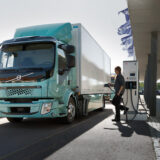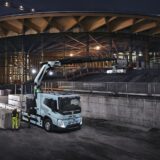Sweden inaugurates world’s first electrified road, paving way for a fossil-free road transport
The first road of its kind to allow both commercial and passenger vehicles to be recharged while driving was inaugurated in Sweden last week.
“One of the most important issues of our time is the question of how to make fossil-free road transportation a reality. We now have a solution that will make this possible, which is amazing. Sweden is at the cutting edge of this technology, which we now hope to introduce in other areas of the country and the world,” says Hans Säll, chairman of the eRoadArlanda consortium and business development director at NCC, one of the leading construction and property development companies in the Nordic region.
The eRoadArlanda project is working to make electrified roads of the future a reality and is part of the Swedish Transport Administration’s pre-commercial procurement of innovation. The solution is based on conductive technology that uses an electric rail installed in roads to power and recharge vehicles during their journey.
Road traffic accounts for a third of Sweden’s carbon emissions. It has been estimated that only the major routes – around 3% of the total road network in Sweden – would need to be modified to significantly reduce the country’s carbon emissions. Shorter journeys between these major routes could be undertaken using the electric vehicles’ stored battery power.
Swedish Minister for Infrastructure Tomas Eneroth and Lena Erixon, director general of the Swedish Transport Administration, were on hand at the formal inauguration ceremony for the road.
“It is important to break new ground when it comes to climate-smart road transport. That’s why the Swedish Transport Administration supports innovative development projects that contribute to long-term, sustainable solutions,” says Erixon.
Approximately two kilometers of electric rail have been installed along public road 893, between the Arlanda Cargo Terminal and the Rosersberg logistics area outside Stockholm.
The electrified road works by transferring energy to the vehicle from a rail in the road through a movable arm. The arm detects the location of the rail in the road and as long as the vehicle is above the rail, the contact will be in a lowered position.
The electrified road will be used by electric trucks developed as part of the project.
Over the past decade, Sweden has put several demand-side policies into place to promote plug-in hybrid electric vehicles (PHEVs) and battery electric vehicles (BEVs). As of December 2017, a total of 50,304 light-duty plug-in vehicles have been registered in Sweden since 2011, consisting of 36,405 plug-in hybrids, 12,223 all-electric cars and 1,676 all-electric vans. The market is dominated by plug-in hybrids, representing 74.9% of plug-in car registrations through 2017.
The eRoadArlanda project is being managed by a consortium, comprised of the following members: Elways, NCC, PostNord, ABTbolagen, Vattenfall, DAF, KTH, Kilenkrysset, VTI, E-traction, GCT, KTH, Bilprovningen, Airport City Stockholm, Sigtuna Municipality, Swedavia, Arlanda Stad Holding, TraningPartner, FirstHotel, Frost Produktion, SMM Dulevo and Sandströms Elfirma.
The advantage of electrifying roads is that existing infrastructure can have its energy consumption and carbon emissions reduced with minimal modification.
Sweden is already a world leader in clean energy, although Norway has the distinction of having the highest number of electric vehicles in Europe. In 2015 Swedish Prime Minister Stefan Löfven announced his country would move towards becoming “one of the first fossil fuel-free welfare states in the world.”











.jpg)
